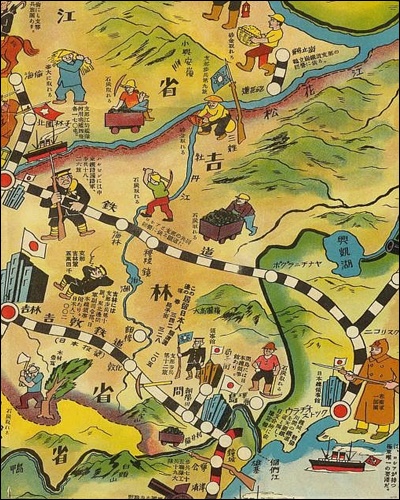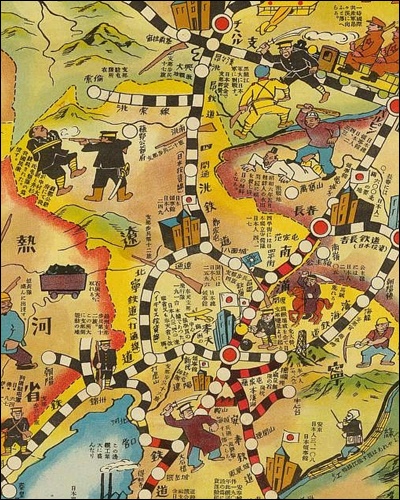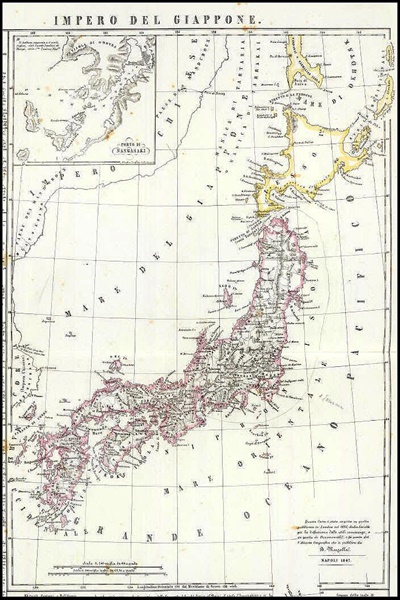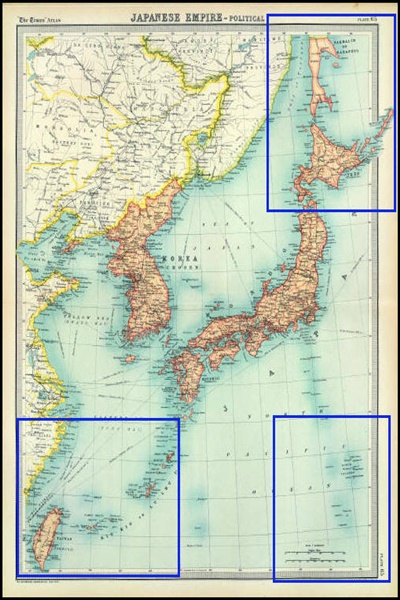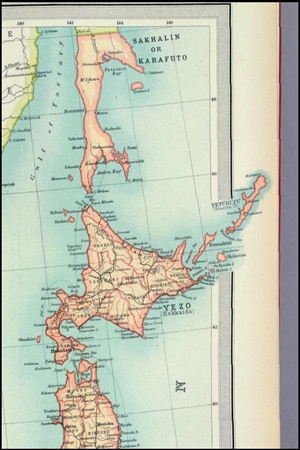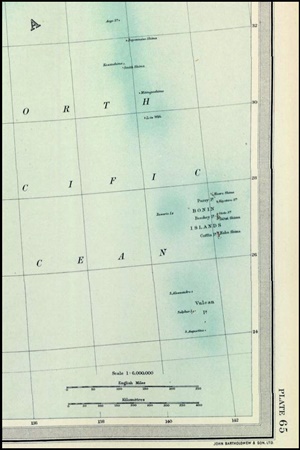The annexation of Tokdo during the Russo-Japanese War (1904-1905) should be examined in the vein of Japan’s pursuit of an expansionist policy and analysed in the overall process of the demarcation of territories by Korea (South and North), China, Russia, the Philippines and the U.S.
Japan’s post-war move to claim Tokdo as its territory is linked to its colonization of Ainu Moshiri and Okinawa and this move, along with its demand for the reversion of the northern islands, may be viewed as Japan’s return to its imperialist expansionist policy of the past.
The Korean publications in the 15th century record the existence of Tokdo and the Korean government has included it in its territory since the 15th century .Historically and geographically, Ulleungdo and Tokdo are considered inseparable in Korea, and if Ulleungdo comes within the territory of Korea, so does Tokdo: One cannot be separated from the other. To recognize Ulleungdo as Korea’s possession and negate its ownership of Tokdo is like admitting Korea’s title to Chejudo but denying it to Marado, its adjoining island.
Invasion of Ulleungdo by Japanese Pirates
In 1618, the Tokugawa Shogunate issued a permit, through Shimane province, to Otani Jinkichi and Murakami Ichihei of Yon- ago to make passage to Ullungdo. For 78 years thereafter, these two families trespassed on the island.
In 1667, Saito Hosen, a retainer of Izumo-han (Izumo province) inspected Onshu (Oki Island) on orders of his lord and compiled Onshu shicho goki (Records of Observations on Onshu) in 1667. In Vol. I of the book, Tokdo was referred to as “Matsushima” and Ullungdo “Takeshima.”
In 1693, An Yong-bok from Tongnae and other fishermen clashed with the Japanese on Ulleungdo. He and Pak O-dun were taken to Yonago as hostages. With this event as the turning point, the Shogunate recognized Korea’s ownership of Ullungdo and banned Japanese voyages to the island in 1696. But Japanese continued crossing to the island and poaching and secretly felling trees there.
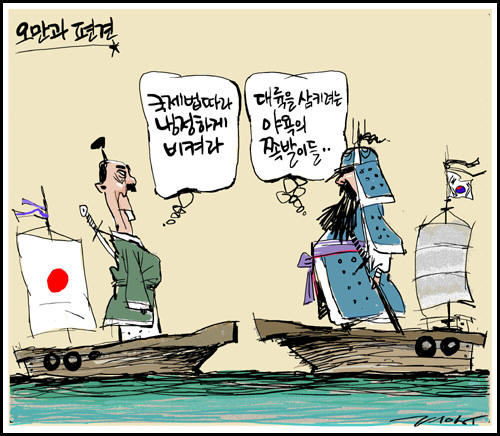 In February 1876, an unequal treaty was signed between Korea and Japan: it was the Treaty of Friendship, also known as the Treaty of Kanghwa, (link)which marked the encroachment of Japanese on Korea and their indulgence in fishing and logging on Ulleungdo. As the name of Ulleungdo (鬱陵島) -literally an island of luxuriant trees suggests, the island was densely forested at that time.
In February 1876, an unequal treaty was signed between Korea and Japan: it was the Treaty of Friendship, also known as the Treaty of Kanghwa, (link)which marked the encroachment of Japanese on Korea and their indulgence in fishing and logging on Ulleungdo. As the name of Ulleungdo (鬱陵島) -literally an island of luxuriant trees suggests, the island was densely forested at that time.
On March 29, 1877, the Japanese Council of State (Dajokan) published a document saying that Ulleungdo and Tokdo were not Japanese territories. This decision was transmitted to Shimane prefecture on April 9th of that year. In 1880, the Japanese warship Amagi conducted a survey of Ulleungdo, and in December 1882, the Korean government issued a decree to develop Ulleungdo.
In March 1883, the Japanese government confirmed the Korean ownership of Ulleungdo (Matsushima) and placed a ban on Japanese passage to the island and evacuated a total of 254 Japanese engaged in poaching and illegal logging from the island in October of that year.
To the right, in a Korean newspaper cartoon, ancient Korean and Japanese fishermen argue. “Takeshima belongs to Japan under International Law..” quotes the Japanese sailor. “Greedy Jap expansionist devouring territory !” replies the outraged Korean.
As a result, the Korean government expelled the Japanese from the island. In 1898, Pae Kye-ju, administrator of Ulleungdo, went over to Matsue in Japan to start a lawsuit there and was awarded 300 Japanese yen for illegal lumbering by Japanese on Ulleungdo, but the money was stolen from him by Japanese.
Two months after a large-scale sea battle between the Japanese and Russian fleets fought on May 28, 1905, (link 1 2) the Japanese Navy built a watchtower on Tokdo.(link 1, 2, 3,) In addition on September 29, 1904, Nakai Yosaburo submitted an application for the incorporation of the Liancourt Rocks (Tokdo) into Japanese territory and for its lease to the Ministries of Foreign Affairs, Home Affairs, and Agriculture Commerce-Industry.
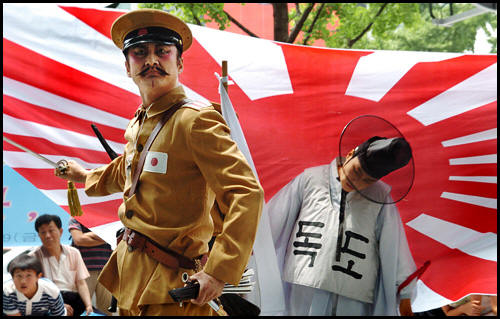 The Japanese cabinet decided on January 28, 1905, to incorporate Tokdo into its territory, to name it “Takeshima,” and to place the island under the control of Okinoshima in Shimane prefecture. Up to that time, Japanese had called Ulleungdo “Takeshima” or “Isonotakeshima,” and Tokdo “Matsushima,” and never called Tokdo “Takeshima.” In the midst of the Russo-Japanese War, the Japanese government attempted to take possession of a Korean island while it was even unsure of its accurate appellation in the Japanese language.
The Japanese cabinet decided on January 28, 1905, to incorporate Tokdo into its territory, to name it “Takeshima,” and to place the island under the control of Okinoshima in Shimane prefecture. Up to that time, Japanese had called Ulleungdo “Takeshima” or “Isonotakeshima,” and Tokdo “Matsushima,” and never called Tokdo “Takeshima.” In the midst of the Russo-Japanese War, the Japanese government attempted to take possession of a Korean island while it was even unsure of its accurate appellation in the Japanese language.
To the left, one Korean actor portrays himself as Dokdo Island while another acts as an Imperial Japanese soldier from 1905. Koreans understand the inseparability of Japan’s 1905 annexation of Dokdo from Japanese expansionism during the colonial era. Hence, Japan’s demands to reclaim Dokdo as seen a modern an re-invasion of Korean territory.
Until 1905 when Japan seized Tokdo, the Japanese Foreign Ministry had never separated Tokdo from Ulleungdo as Korean territory. In other words, it had recognized the Korean ownership of both islands. Also, around the close of the 19th century, the Hydrographic Bureau of the Japanese Navy admitted Tokdo and UIleungdo as territory of Korea.
On February 22, 1905, Shimane prefecture published Public Notice No.40 wherein it announced that Takeshima (Tokdo) had come under its jurisdiction and entered the island in the land register. Korea became aware of this fact only at the end of March 1906, when a group of Shimane prefecture officials, during their inspection trip to Tokdo, visited Sim Hung-t’aek, chief of Ulleungdo county, and informed him of the incorporation of the island into Japanese territory .Sim immediately reported this fact to the central government. Four months before this, Korea was made Japan’s protectorate, and Ito Hirobumi was posted in Seoul as Resident- General in March 1906, and conducted diplomatic functions in lieu of the Korean government. It was in July of the same year that the governor of Shimane prefecture leased Tokdo to Takeshima Fishing and Hunting Co., Ltd., headed by Nakai Yozaburo.
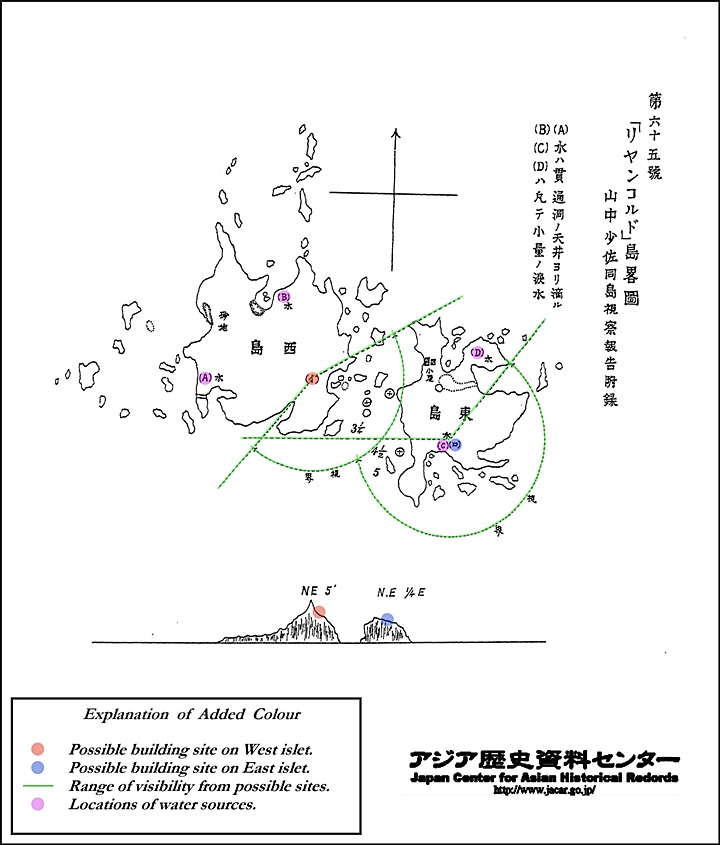 As the incorporation of Tokdo was not published in the official gazette of the Japanese government, the fact was not widely and accurately known even among the Japanese people. In the Chosen Shin Shirishi (New Gazetteer of Korea) by Adachi Ritsuen published in Osaka in December 1910, “Takeshima” is shown as Korea’s island.
As the incorporation of Tokdo was not published in the official gazette of the Japanese government, the fact was not widely and accurately known even among the Japanese people. In the Chosen Shin Shirishi (New Gazetteer of Korea) by Adachi Ritsuen published in Osaka in December 1910, “Takeshima” is shown as Korea’s island.
The demographic statistics of Ulleungdo by the end of 1910 were as follows: “The Japanese migrants total 224 households; the majority of them from Okinoshima, making the island a sort of dependency; in terms of the ratio between Japanese and Koreans, it ranks first in favor of the Japanese migrants in Korea.”
The map to the right, is a Japanese Naval survey map of Dokdo. It was drawn by Vice Commander Yamaka of the warship Tsushima. The island was surveyed for constructing military watchtowers months before Dokdo was annexed. (map is enhanced, click for detail)
According to the statistics by the Japanese Government-General in Korea, the Japanese on Ullungdo numbered 656 (186 households] and their original domiciles were Hiroshimaken, Yamaguchiken, Oitaken, and Hokkaido as of the end of 1922; the households reached 400 in 1917; a fisheries cooperative was organized in February 1914, and its membership stood at 245 Koreans and 130 Japanese at the end of 1922.
On April 24 1939, Tokdo was incorporated into Gokamura in Okinoshima. It was designated for naval use and placed under the control of Maizuru Naval Station. The Japanese government made Tokdo a national property under the jurisdiction of the Ministry of Finance.
Having thus annexed the northern island of Hokkaido, a part of Ainu Moshiri, Japan went on to invade the Ryukyu Kingdom, Taiwan, Korea, China, Mongolia, Micronesia, and Southeast Asian countries. In the process of this aggression, Japan developed a nation-state, and while creating this nation-state, Japan expanded its colonies and its area of occupation. The loyal subjects of Japan invaded the areas and countries in Asia and the Pacific as soldiers, police, landlords, civil servants, farmer-and fisherman-migrants, tradesmen, and agents of aggressive business enterprises.
In Ainu Moshiri, i.e. Hokkaido, Sakhalin and the Kuriles, the Japanese became the overwhelming majority. This is true also of Micronesia. In these areas, the Japanese assimilated the indigenous peoples and forced the Japanese language upon them. The Japanese government endeavored to Japanize all the areas it colonized.
Up to 1946, all Japanese had been the loyal subjects of the emperor and the government had attempted to force this emperor system upon all of its colonies. The Japanese still maintain this tennosei or emperor system.
1. Japanese Expansion Northward
The Japanese imperialists turned the Ainu land into Japanese territory, robbed them of their trading rights, locked them up in Japan, forced them to use the Japanese language, all in an attempt to assimilate them. The Japanese “emigrants” who invaded the Ainu Moshiri destroyed the natural environment of the Ainu and ravaged their land to live and work on it. Many “Kotan” (villages) of the Ainu have become extinct.
Following the Russo-Japanese War, Japan added the southern half of Sakhalin, part of the Ainu Moshiri, to its territory , and the Japanese came en masse to the new land. In 1926 and 1927, the aborigines of southern Sakhalin were forcibly moved to a narrow strip of reservation called “Otasu no mori” or the wood of Otasu.
In March 1876, the Japanese government placed the Bonin Islands under the control of the Ministry of Home Affairs and turned them into a Japanese territory .By 1882 all the people of the islands had acquired Japanese nationality.
Three years later in 1879, the Japanese government dispatched troops and police to the Ryukyu Kingdom and brought it into the Japanese Empire. The emperor system was enforced and the King was made a Japanese peer. In September 1891, the Iojima came under Japanese control.
After the Sino-Japanese War, China (Ch’ing) ceded Taiwan, the Pescadores, and the Liatung Peninsula to Japan in accordance with the peace treaty signed in April 1895. At this time, Japan took posses- sion of the Miyako- Yaeyama area (Miyako, Ishigaki, Iriomote and others) and placed them under the supervision of Okinawa prefecture.
In 1914, Japan colonized Micronesia which had been a trust territory of Germany. In 1923 and 1926, the Japanese warship Manshu conducted a survey of Okinotorishima, and the Japanese government, by means of a Ministry of Home Affairs public notice, placed the island under the jurisdiction of the administrator of the Bonins, two months prior to the Japanese invasion of northeast China. (September 18th Incident)
Following World War II, Japan was forced to relinquish Micronesia to the U.S. which conducted hydrogen bomb tests there. In 1987, Japan hardened the perimeter of Okinotorishima with reinforced concrete. Okinotorishima, the reefs only 70cm. high at a full tide, became the southern boundary of Japan.
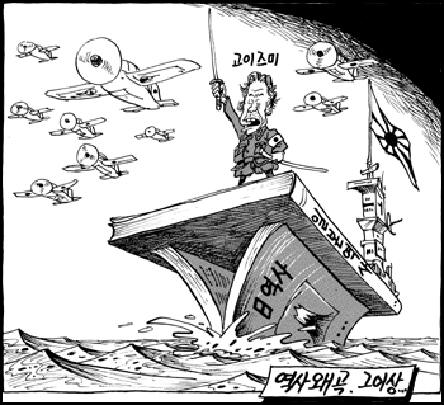 In 1931, after the September 18th Incident, Japan colonized Northeast China and Southeast Mongolia and founded Manchukuo, later renamed the Manchurian Empire; set up a puppet government in North China; and occupied Hong Kong and Hainan Island, expanding the Japanese empire’s domain. In Japan, Taiwan, Korea, and Northeast China, the Japanese imperialists propagandized the slogans: “Japan and Taiwan are one body,” “Japan and Korea are one body ,” “Manchukuo and Korea are like one,” and “Five Races in Harmony.”
In 1931, after the September 18th Incident, Japan colonized Northeast China and Southeast Mongolia and founded Manchukuo, later renamed the Manchurian Empire; set up a puppet government in North China; and occupied Hong Kong and Hainan Island, expanding the Japanese empire’s domain. In Japan, Taiwan, Korea, and Northeast China, the Japanese imperialists propagandized the slogans: “Japan and Taiwan are one body,” “Japan and Korea are one body ,” “Manchukuo and Korea are like one,” and “Five Races in Harmony.”
To the right, This Korean political cartoon depicts Japanese President Koizumi re-invading Asia on a warship made of Japanese history books that distort the truth of Japan’s past.
6. Greater East Asia Co-Prosperity Sphere
The Japanese government issued an outline of Japanese state policy for “the construction of a new order for Greater East Asia” in July 1940, and in September the Imperial Headquarters-Government Liaison Committee defined Japan’s Lebensraum for “the construction of a new order for Greater East Asia.”
In February 1941, the Liaison Committee classified the whole world into the four spheres of Greater East Asia, Europe, the U.S. and Russia, and declared that “Japan would assume the political leadership for the Greater East Asia Co-Prosperity Sphere and shoulder the responsibility of maintaining order.” Imperial Japan attempted to divide the world with imperialist countries and Soviet Russia and carve out a Greater East Asia Co-Prosperity Sphere for itself.
In May 1943, “General Rules for Political Leadership for Greater East Asia” were decided on at the joint conference of Emperor Hirohito, the Japanese government and the leaders of the armed forces including Tojo Hideki. The conference made a decision to incorporate into the Japanese Empire’s territory Malaya, Sumatra, Java, Borneo and Celebes. The emperor and other imperialists attempted to turn these areas into Japanese territories and then into the “supply sources for essential natural resources.”
They sent Japanese troops to many parts of the Greater East Asia Co-Prosperity Sphere in the Pacific under the slogan of the “whole world under one roof,” and brought great calamities to the native people
1. Decrease in Japan’s Territory
In 1899, the Japanese government enacted an act for the protection of the aborigines. Under the act, a small wasteland from the territory Japan had taken was “awarded” as a reservation for the. Ainu to cultivate, and under the pretext of protection, the Japanese government sought to assimilate them completely. This act where- in the Ainu are called “former aborigines” is still in force. In April 1996, about 100 years after the act was promulgated, an informal comittee of “learned people on possible measures for the Utari,” an unofficial advisory council of the Chief Cabinet Secretary of the government, was organized. It published a report which reads in part:
In the history , at least from the latter part of the medieval ages, it cannot be denied that the northern periphery of the Japan archipelago, particularly Hokkaido that is an inherent part of the Japanese territory, was inhabited by the aborigines.
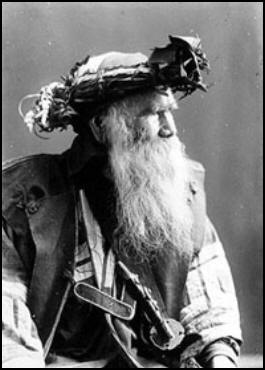 The “learned people” claimed the homeland of northern peoples as an inherent part of the Japanese territory. It is worth remembering at this point that Japan named the part of the Ainu Moshiri Hokkaido only in 1869. This speaks for itself that Hokkaido is not an inherent part of the Japanese territory, but a colony of Japan. As Korea was freed from Japan’s occupation, the Ainu Moshiri (see picture to left) should be liberated from the control of Japan.
The “learned people” claimed the homeland of northern peoples as an inherent part of the Japanese territory. It is worth remembering at this point that Japan named the part of the Ainu Moshiri Hokkaido only in 1869. This speaks for itself that Hokkaido is not an inherent part of the Japanese territory, but a colony of Japan. As Korea was freed from Japan’s occupation, the Ainu Moshiri (see picture to left) should be liberated from the control of Japan.
The report also states: Since the Meiji Restoration, our country has started as a modern state, and in the process of the development of Hokkaido… the Ainu have suffered decisive damage socially and culturally… many Ainu have been discriminated against and reduced to poverty.
The physical environment of the Ainu has become dilapidated; the places for life and livelihood of the Ainu have been laid waste; kotan “villages” have degenerated, while Japanese have tried to assimilate them. Racial discrimination has continued, and they have been deprived of their language. These have been done by the Japanese, while the Ainu have been kept from hunting and fishing salmon. In the possession of the Ainu Moshiri, Japan has not desisted from invading other areas and other countries.
Japan refers to the four northern islands as northern territories and is demanding Russia return them. The Russian government should turn the islands not to Japan, but to their original inhabitants; Japan and Russia must return them to the original owners, the Ainu Moshiri (Sakhalin, the Kuriles, Hokkaido and the Mar- itime Province of Siberia.)
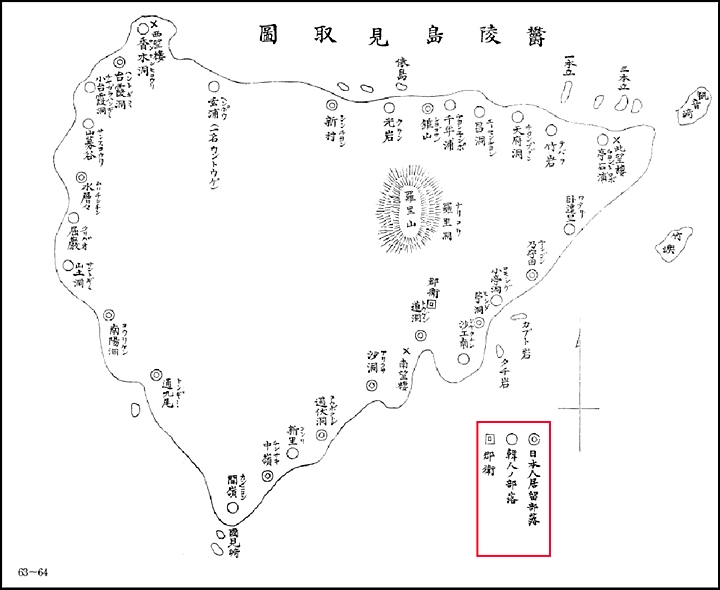 After the Tonghak Peasant Army was routed in their revolutionary uprising in 1894, the Korean people could not check the onslaught of the Japanese. In the process of the Japanese colonization of Korea at the turn of the century , the Tulmmen River became the Sino-Korean boundary and Kando (Chinese: Chientao) in Manchuria became a Chinese (Ch’ing) territory.
After the Tonghak Peasant Army was routed in their revolutionary uprising in 1894, the Korean people could not check the onslaught of the Japanese. In the process of the Japanese colonization of Korea at the turn of the century , the Tulmmen River became the Sino-Korean boundary and Kando (Chinese: Chientao) in Manchuria became a Chinese (Ch’ing) territory.
To the right, This early 1900s Japanese map of Ulleungdo shows Korean (韓人部落) and Japanese (日本人部落居留) settlements on the island. Here Japanese trespassers’ settlements are marked as “Japanese temporary villages on foreign land”
The history of Tokdo can not be studied properly without taking into account the process of the settlement of Korea’s border- lines and that of Japan’s domination of Korea as its colony.
It may be maintained that Korea had developed as a nation-state with the Tonghak Peasant Uprising as a momentum and during the March 1 Independence Movement of 1919, but this nation-state became divided after its liberation. Tokdo marks the eastern extremity of the Korean territory and its stationing of a police force there is meant to defend it against any attempt of Japan to reoccupy the islets.
“Korea’s rejection was considered just…” According to Prof. Lee Han-key, “..International law is for imperialist countries even today, and it is impossible to depend on international law for clear-cut criteria for definition and demarcation of national boundaries. It can be said that the International Court of Justice is still under the influence of imperialist countries…”
At the beginning of 1910, Foreign Minister Komura Jutaro spoke before the Budget Committee of the House of Representatives of the Diet and noted. To concentrate emigrants in Manchuria and Korea is to concentrate the Yamato (Japanese) people. Prior to the Russo-Japanese War, Japan had been an insular country, but as the result of the war, it has become a sort of continental state.
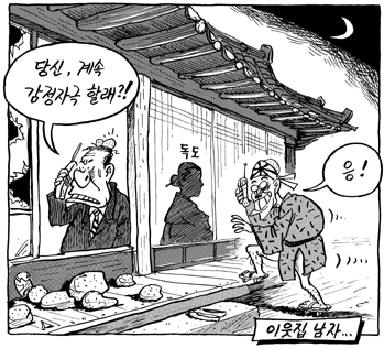 Had Japan not suffered defeat in the Asia and Pacific war, the multitude of Japanese would have settled down permanently in Northeast China, Korea, Taiwan, Saipan, and Palau, forced the emperor system and the Japanese language upon the natives, and dominated them under the slogans of “Five Races in Harmony” or “Korea and Manchuria are like one body.”
Had Japan not suffered defeat in the Asia and Pacific war, the multitude of Japanese would have settled down permanently in Northeast China, Korea, Taiwan, Saipan, and Palau, forced the emperor system and the Japanese language upon the natives, and dominated them under the slogans of “Five Races in Harmony” or “Korea and Manchuria are like one body.”
Those Japanese “emigrants” who had invaded many parts of Asia and the Pacific compelled the local peoples to use the Japanese language, built shinto shrines, and renamed places in the Japanese style. As the war ended, these shrines were destroyed and the place names reverted to the original ones in Taiwan, Korea and Northeast China.
To the right, A Japanese neighbour harasses a Korean man in attempt to covet his wife (Dokdo) “Are you going to keep pestering me?” shouts the Korean husband. “Yup..!!” says the Japanese man.
The history of Japan’s aggression still continues today. The Ainu Moshiri that includes the islands of Kunashiri, Etorofu, Habomai and Shikotan (these .are Ainu words) and that is termed “northern territories” by the Japanese government is the homeland of the Ainu, Uilta, Nivkh and other northern peoples. To free the Ainu Moshiri from the colonial control of Japan is a prerequisite to the task of checking Japan’s reoccupation of Tokdo.
In the midst of the imperialistic war between Japan and Russia, both trying to colonize Korea, the former took possession of Tokdo and proceeded to annex all of Korea. It was 36 years before its occupation of Tokdo that Japan named Ainu Moshiri Hokkaido and incorporated it into its territory.
Historically, Tokdo has been within the domain of Korea, and it will become apart of the territory of a unified Korea in the future. It is the territory of South Korea now. If the Japanese. scholars of the modern and contemporary history of Asia wish to forestall Japan’s designs of aggression on other lands and countries, they are advised to cope squarely with the Japanese move to reoccupy Tokdo and re-claim the title of the northern islands. This research activity involves an ideological implication to concur with or negate aggression. It bears on the basic perception of history of the researcher.
If a researcher wishes to check Japan’ s attempt at the reoccupation of Tokdo he or she should clarify the fact and the historical meaning of the occupation of Tokdo in the course of Japan’s aggression against Korea, and examine critically the history of Japanese emigration, i.e. the history of Japan’s colonization of foreign lands and people.

